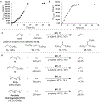Catalytic deconstruction of waste polyethylene with ethylene to form propylene
- PMID: 36173865
- PMCID: PMC11723507
- DOI: 10.1126/science.add1088
Catalytic deconstruction of waste polyethylene with ethylene to form propylene
Abstract
The conversion of polyolefins to monomers would create a valuable carbon feedstock from the largest fraction of waste plastic. However, breakdown of the main chains in these polymers requires the cleavage of carbon-carbon bonds that tend to resist selective chemical transformations. Here, we report the production of propylene by partial dehydrogenation of polyethylene and tandem isomerizing ethenolysis of the desaturated chain. Dehydrogenation of high-density polyethylene with either an iridium-pincer complex or platinum/zinc supported on silica as catalysts yielded dehydrogenated material containing up to 3.2% internal olefins; the combination of a second-generation Hoveyda-Grubbs metathesis catalyst and [PdP(tBu)3(μ-Br)]2 as an isomerization catalyst selectively degraded this unsaturated polymer to propylene in yields exceeding 80%. These results show promise for the application of mild catalysis to deconstruct otherwise stable polyolefins.
Conflict of interest statement
Figures




Similar articles
-
Chemical Recycling of Polyethylene by Tandem Catalytic Conversion to Propylene.J Am Chem Soc. 2022 Oct 12;144(40):18526-18531. doi: 10.1021/jacs.2c07781. Epub 2022 Sep 30. J Am Chem Soc. 2022. PMID: 36178850
-
Catalytic Decomposition of Long-Chain Olefins to Propylene via Isomerization-Metathesis Using Latent Bicyclic (Alkyl)(Amino)Carbene-Ruthenium Olefin Metathesis Catalysts.Angew Chem Int Ed Engl. 2022 Jul 11;61(28):e202204413. doi: 10.1002/anie.202204413. Epub 2022 May 19. Angew Chem Int Ed Engl. 2022. PMID: 35420225 Free PMC article.
-
Homo-polymerization of alpha-olefins and co-polymerization of higher alpha-olefins with ethylene in the presence of CpTiCl2(OC6H4X-p)/MAO catalysts (X = CH3, Cl).Molecules. 2005 Jul 4;10(6):659-71. doi: 10.3390/10060659. Molecules. 2005. PMID: 18007336 Free PMC article.
-
Ethenolysis: A Green Catalytic Tool to Cleave Carbon-Carbon Double Bonds.Chemistry. 2016 Aug 22;22(35):12226-44. doi: 10.1002/chem.201601052. Epub 2016 Jun 30. Chemistry. 2016. PMID: 27359344 Review.
-
One step formation of propene from ethene or ethanol through metathesis on nickel ion-loaded silica.Molecules. 2011 Sep 13;16(9):7844-63. doi: 10.3390/molecules16097844. Molecules. 2011. PMID: 22143546 Free PMC article. Review.
Cited by
-
Circular Melt-Spun Textile Fibers from Polyethylene-like Long-Chain Polyesters.ACS Appl Polym Mater. 2024 Jul 30;6(15):9219-9225. doi: 10.1021/acsapm.4c01570. eCollection 2024 Aug 9. ACS Appl Polym Mater. 2024. PMID: 39144276 Free PMC article.
-
Upcycling polyolefins to methane-free liquid fuel by a Ru1-ZrO2 catalyst.Nat Commun. 2025 Mar 21;16(1):2800. doi: 10.1038/s41467-025-57998-x. Nat Commun. 2025. PMID: 40118830 Free PMC article.
-
Influence of ball milling parameters on the mechano-chemical conversion of polyolefins.RSC Mechanochem. 2024 Dec 18;2(2):263-272. doi: 10.1039/d4mr00098f. eCollection 2025 Mar 4. RSC Mechanochem. 2024. PMID: 39760087 Free PMC article.
-
Recycling polyolefin plastic waste at short contact times via rapid joule heating.Nat Commun. 2024 Jul 5;15(1):5662. doi: 10.1038/s41467-024-50035-3. Nat Commun. 2024. PMID: 38969641 Free PMC article.
-
Chemical recycling of polyolefins: a closed-loop cycle of waste to olefins.Natl Sci Rev. 2023 Aug 2;10(9):nwad207. doi: 10.1093/nsr/nwad207. eCollection 2023 Sep. Natl Sci Rev. 2023. PMID: 37601241 Free PMC article. Review.
References
-
- Coates GW, Getzler YDYL, Nat. Rev. Mater 5, 501–516 (2020).
-
- Ragaert K, Delva L, Van Geem K, Waste Manag 69, 24–58 (2017). - PubMed
-
- Chen L et al., Chem 7, 137–145 (2021).
MeSH terms
Substances
Grants and funding
LinkOut - more resources
Full Text Sources
Other Literature Sources
Research Materials

